Palliative Care
VerifiedAdded on 2022/11/25
|11
|2184
|451
AI Summary
This document provides information on palliative care, including its management strategies and the impact on healthcare professionals. It covers topics such as dyspnea, cachexia anorexia syndrome, respiratory and swallowing difficulties, nutrition and hydration at the end of life, and cultural and spiritual care. The document also includes a case study on the management of non-healing malignant wounds.
Contribute Materials
Your contribution can guide someone’s learning journey. Share your
documents today.
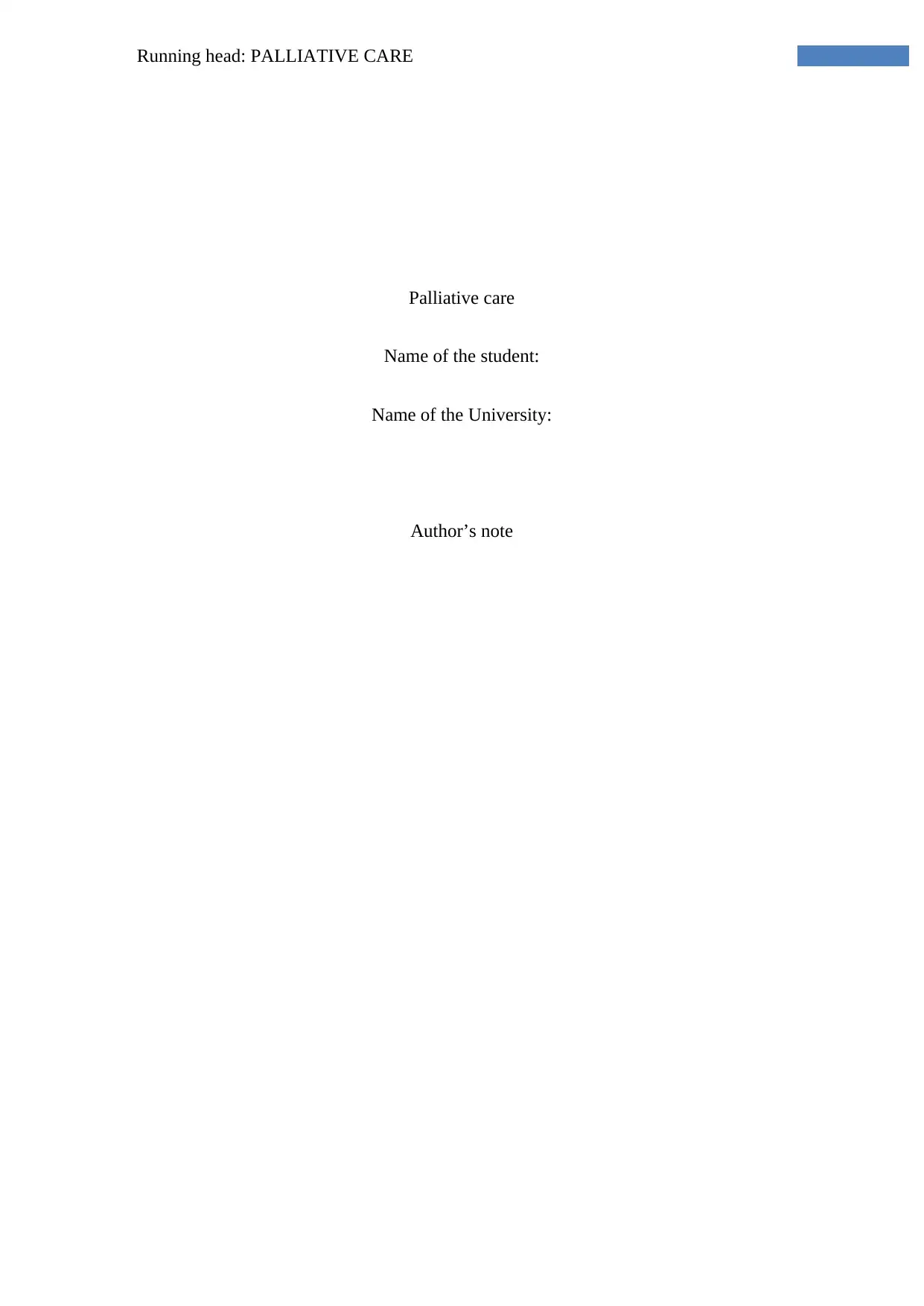
Running head: PALLIATIVE CARE
Palliative care
Name of the student:
Name of the University:
Author’s note
Palliative care
Name of the student:
Name of the University:
Author’s note
Secure Best Marks with AI Grader
Need help grading? Try our AI Grader for instant feedback on your assignments.
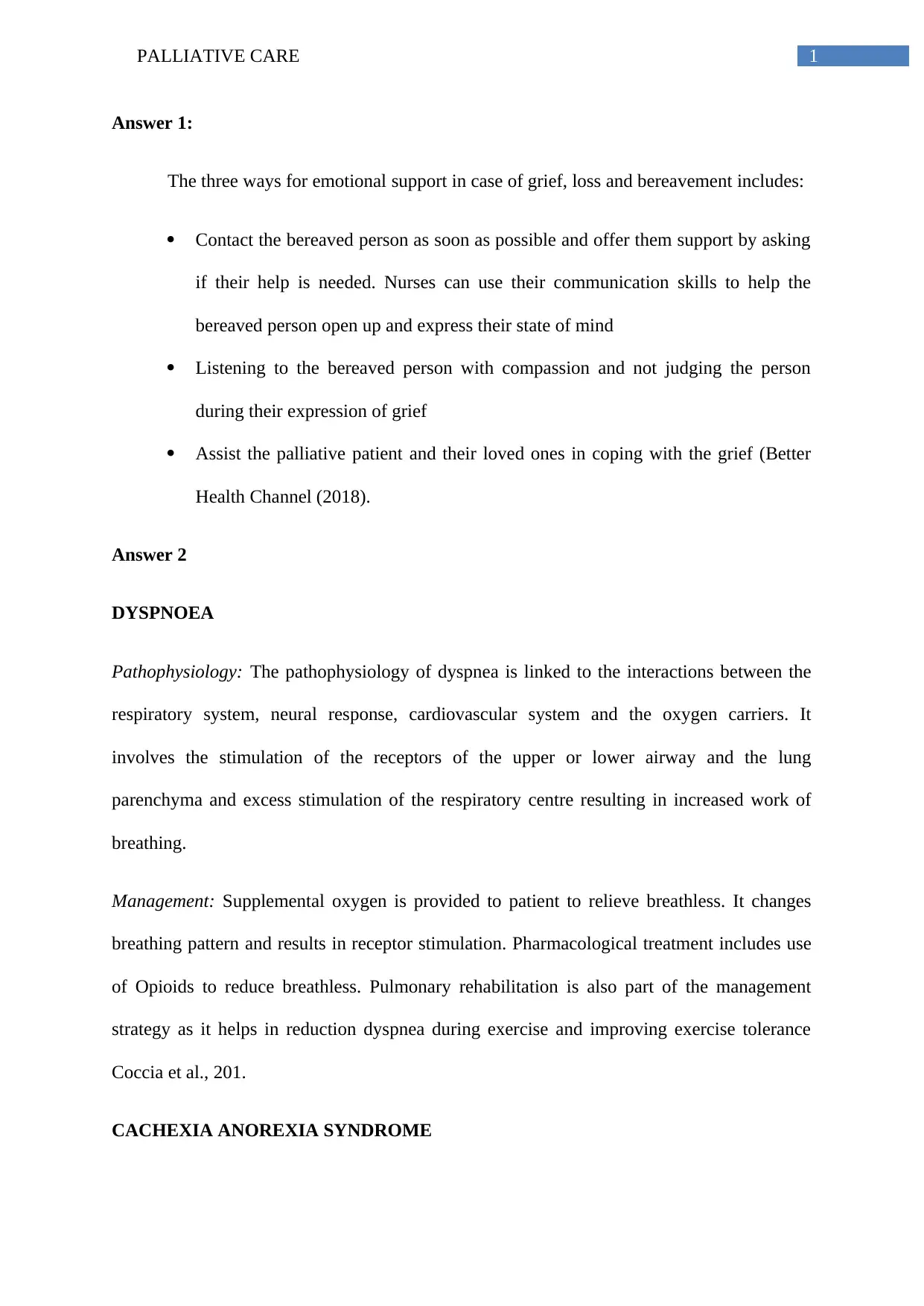
1PALLIATIVE CARE
Answer 1:
The three ways for emotional support in case of grief, loss and bereavement includes:
Contact the bereaved person as soon as possible and offer them support by asking
if their help is needed. Nurses can use their communication skills to help the
bereaved person open up and express their state of mind
Listening to the bereaved person with compassion and not judging the person
during their expression of grief
Assist the palliative patient and their loved ones in coping with the grief (Better
Health Channel (2018).
Answer 2
DYSPNOEA
Pathophysiology: The pathophysiology of dyspnea is linked to the interactions between the
respiratory system, neural response, cardiovascular system and the oxygen carriers. It
involves the stimulation of the receptors of the upper or lower airway and the lung
parenchyma and excess stimulation of the respiratory centre resulting in increased work of
breathing.
Management: Supplemental oxygen is provided to patient to relieve breathless. It changes
breathing pattern and results in receptor stimulation. Pharmacological treatment includes use
of Opioids to reduce breathless. Pulmonary rehabilitation is also part of the management
strategy as it helps in reduction dyspnea during exercise and improving exercise tolerance
Coccia et al., 201.
CACHEXIA ANOREXIA SYNDROME
Answer 1:
The three ways for emotional support in case of grief, loss and bereavement includes:
Contact the bereaved person as soon as possible and offer them support by asking
if their help is needed. Nurses can use their communication skills to help the
bereaved person open up and express their state of mind
Listening to the bereaved person with compassion and not judging the person
during their expression of grief
Assist the palliative patient and their loved ones in coping with the grief (Better
Health Channel (2018).
Answer 2
DYSPNOEA
Pathophysiology: The pathophysiology of dyspnea is linked to the interactions between the
respiratory system, neural response, cardiovascular system and the oxygen carriers. It
involves the stimulation of the receptors of the upper or lower airway and the lung
parenchyma and excess stimulation of the respiratory centre resulting in increased work of
breathing.
Management: Supplemental oxygen is provided to patient to relieve breathless. It changes
breathing pattern and results in receptor stimulation. Pharmacological treatment includes use
of Opioids to reduce breathless. Pulmonary rehabilitation is also part of the management
strategy as it helps in reduction dyspnea during exercise and improving exercise tolerance
Coccia et al., 201.
CACHEXIA ANOREXIA SYNDROME
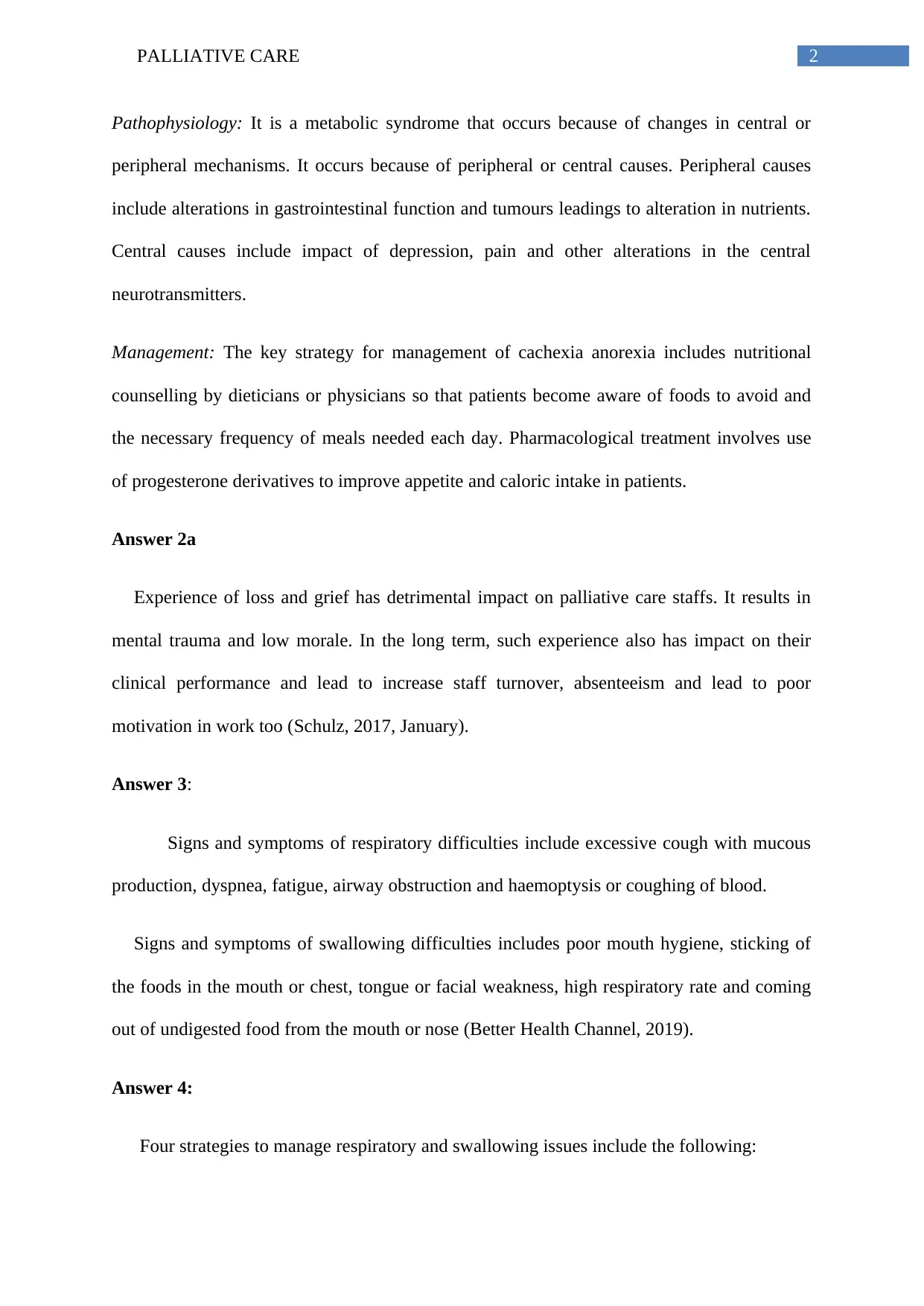
2PALLIATIVE CARE
Pathophysiology: It is a metabolic syndrome that occurs because of changes in central or
peripheral mechanisms. It occurs because of peripheral or central causes. Peripheral causes
include alterations in gastrointestinal function and tumours leadings to alteration in nutrients.
Central causes include impact of depression, pain and other alterations in the central
neurotransmitters.
Management: The key strategy for management of cachexia anorexia includes nutritional
counselling by dieticians or physicians so that patients become aware of foods to avoid and
the necessary frequency of meals needed each day. Pharmacological treatment involves use
of progesterone derivatives to improve appetite and caloric intake in patients.
Answer 2a
Experience of loss and grief has detrimental impact on palliative care staffs. It results in
mental trauma and low morale. In the long term, such experience also has impact on their
clinical performance and lead to increase staff turnover, absenteeism and lead to poor
motivation in work too (Schulz, 2017, January).
Answer 3:
Signs and symptoms of respiratory difficulties include excessive cough with mucous
production, dyspnea, fatigue, airway obstruction and haemoptysis or coughing of blood.
Signs and symptoms of swallowing difficulties includes poor mouth hygiene, sticking of
the foods in the mouth or chest, tongue or facial weakness, high respiratory rate and coming
out of undigested food from the mouth or nose (Better Health Channel, 2019).
Answer 4:
Four strategies to manage respiratory and swallowing issues include the following:
Pathophysiology: It is a metabolic syndrome that occurs because of changes in central or
peripheral mechanisms. It occurs because of peripheral or central causes. Peripheral causes
include alterations in gastrointestinal function and tumours leadings to alteration in nutrients.
Central causes include impact of depression, pain and other alterations in the central
neurotransmitters.
Management: The key strategy for management of cachexia anorexia includes nutritional
counselling by dieticians or physicians so that patients become aware of foods to avoid and
the necessary frequency of meals needed each day. Pharmacological treatment involves use
of progesterone derivatives to improve appetite and caloric intake in patients.
Answer 2a
Experience of loss and grief has detrimental impact on palliative care staffs. It results in
mental trauma and low morale. In the long term, such experience also has impact on their
clinical performance and lead to increase staff turnover, absenteeism and lead to poor
motivation in work too (Schulz, 2017, January).
Answer 3:
Signs and symptoms of respiratory difficulties include excessive cough with mucous
production, dyspnea, fatigue, airway obstruction and haemoptysis or coughing of blood.
Signs and symptoms of swallowing difficulties includes poor mouth hygiene, sticking of
the foods in the mouth or chest, tongue or facial weakness, high respiratory rate and coming
out of undigested food from the mouth or nose (Better Health Channel, 2019).
Answer 4:
Four strategies to manage respiratory and swallowing issues include the following:
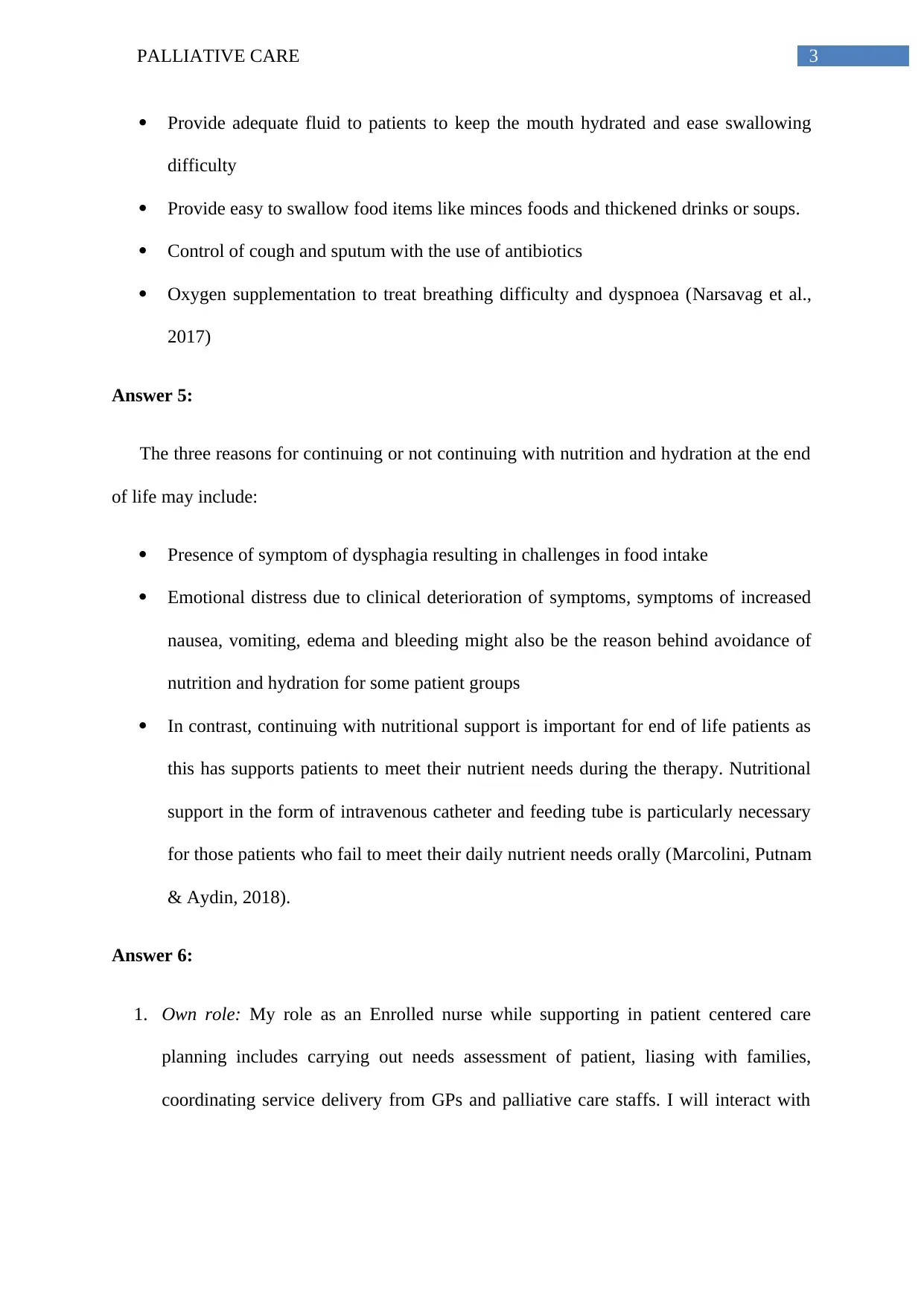
3PALLIATIVE CARE
Provide adequate fluid to patients to keep the mouth hydrated and ease swallowing
difficulty
Provide easy to swallow food items like minces foods and thickened drinks or soups.
Control of cough and sputum with the use of antibiotics
Oxygen supplementation to treat breathing difficulty and dyspnoea (Narsavag et al.,
2017)
Answer 5:
The three reasons for continuing or not continuing with nutrition and hydration at the end
of life may include:
Presence of symptom of dysphagia resulting in challenges in food intake
Emotional distress due to clinical deterioration of symptoms, symptoms of increased
nausea, vomiting, edema and bleeding might also be the reason behind avoidance of
nutrition and hydration for some patient groups
In contrast, continuing with nutritional support is important for end of life patients as
this has supports patients to meet their nutrient needs during the therapy. Nutritional
support in the form of intravenous catheter and feeding tube is particularly necessary
for those patients who fail to meet their daily nutrient needs orally (Marcolini, Putnam
& Aydin, 2018).
Answer 6:
1. Own role: My role as an Enrolled nurse while supporting in patient centered care
planning includes carrying out needs assessment of patient, liasing with families,
coordinating service delivery from GPs and palliative care staffs. I will interact with
Provide adequate fluid to patients to keep the mouth hydrated and ease swallowing
difficulty
Provide easy to swallow food items like minces foods and thickened drinks or soups.
Control of cough and sputum with the use of antibiotics
Oxygen supplementation to treat breathing difficulty and dyspnoea (Narsavag et al.,
2017)
Answer 5:
The three reasons for continuing or not continuing with nutrition and hydration at the end
of life may include:
Presence of symptom of dysphagia resulting in challenges in food intake
Emotional distress due to clinical deterioration of symptoms, symptoms of increased
nausea, vomiting, edema and bleeding might also be the reason behind avoidance of
nutrition and hydration for some patient groups
In contrast, continuing with nutritional support is important for end of life patients as
this has supports patients to meet their nutrient needs during the therapy. Nutritional
support in the form of intravenous catheter and feeding tube is particularly necessary
for those patients who fail to meet their daily nutrient needs orally (Marcolini, Putnam
& Aydin, 2018).
Answer 6:
1. Own role: My role as an Enrolled nurse while supporting in patient centered care
planning includes carrying out needs assessment of patient, liasing with families,
coordinating service delivery from GPs and palliative care staffs. I will interact with
Secure Best Marks with AI Grader
Need help grading? Try our AI Grader for instant feedback on your assignments.
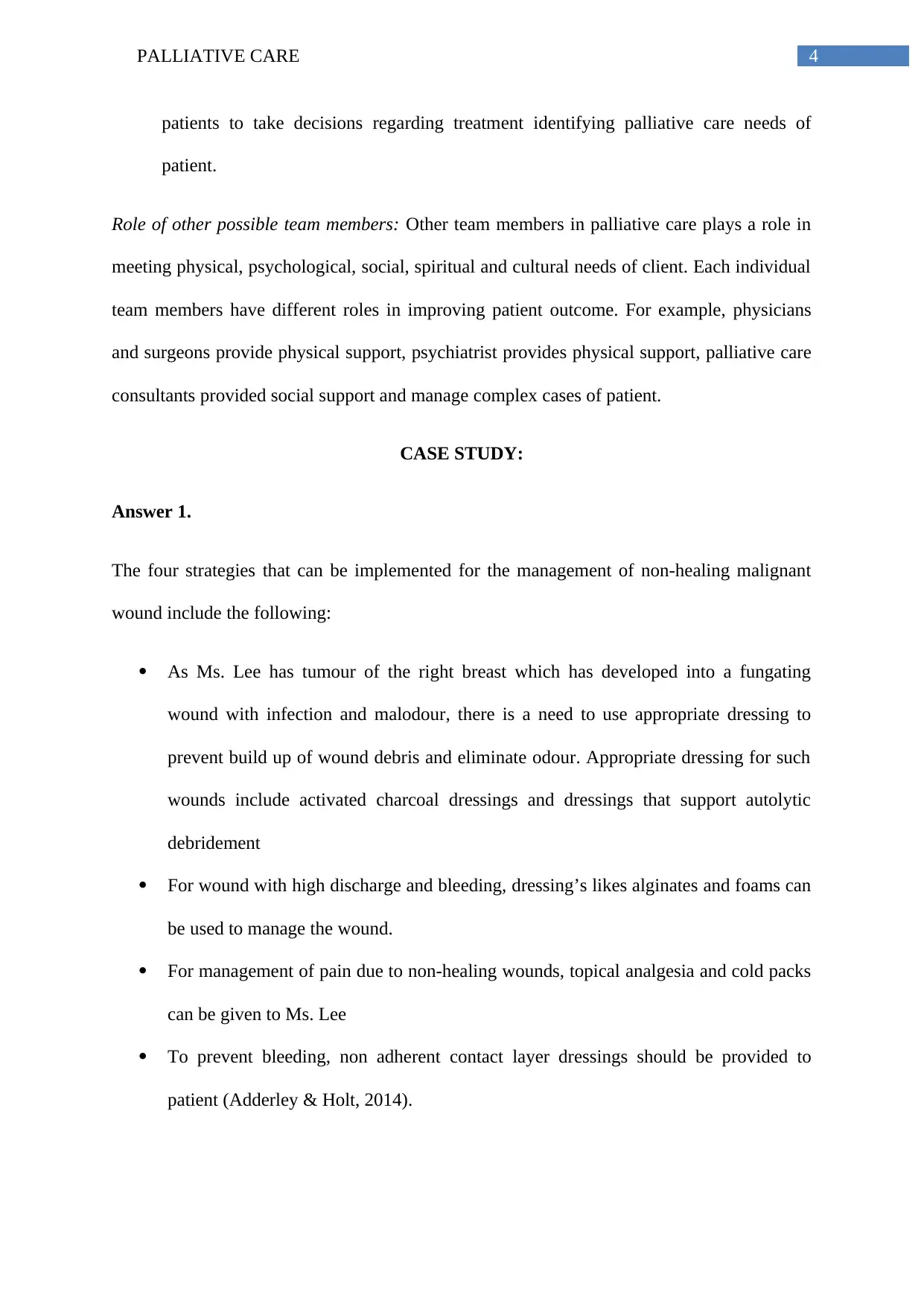
4PALLIATIVE CARE
patients to take decisions regarding treatment identifying palliative care needs of
patient.
Role of other possible team members: Other team members in palliative care plays a role in
meeting physical, psychological, social, spiritual and cultural needs of client. Each individual
team members have different roles in improving patient outcome. For example, physicians
and surgeons provide physical support, psychiatrist provides physical support, palliative care
consultants provided social support and manage complex cases of patient.
CASE STUDY:
Answer 1.
The four strategies that can be implemented for the management of non-healing malignant
wound include the following:
As Ms. Lee has tumour of the right breast which has developed into a fungating
wound with infection and malodour, there is a need to use appropriate dressing to
prevent build up of wound debris and eliminate odour. Appropriate dressing for such
wounds include activated charcoal dressings and dressings that support autolytic
debridement
For wound with high discharge and bleeding, dressing’s likes alginates and foams can
be used to manage the wound.
For management of pain due to non-healing wounds, topical analgesia and cold packs
can be given to Ms. Lee
To prevent bleeding, non adherent contact layer dressings should be provided to
patient (Adderley & Holt, 2014).
patients to take decisions regarding treatment identifying palliative care needs of
patient.
Role of other possible team members: Other team members in palliative care plays a role in
meeting physical, psychological, social, spiritual and cultural needs of client. Each individual
team members have different roles in improving patient outcome. For example, physicians
and surgeons provide physical support, psychiatrist provides physical support, palliative care
consultants provided social support and manage complex cases of patient.
CASE STUDY:
Answer 1.
The four strategies that can be implemented for the management of non-healing malignant
wound include the following:
As Ms. Lee has tumour of the right breast which has developed into a fungating
wound with infection and malodour, there is a need to use appropriate dressing to
prevent build up of wound debris and eliminate odour. Appropriate dressing for such
wounds include activated charcoal dressings and dressings that support autolytic
debridement
For wound with high discharge and bleeding, dressing’s likes alginates and foams can
be used to manage the wound.
For management of pain due to non-healing wounds, topical analgesia and cold packs
can be given to Ms. Lee
To prevent bleeding, non adherent contact layer dressings should be provided to
patient (Adderley & Holt, 2014).
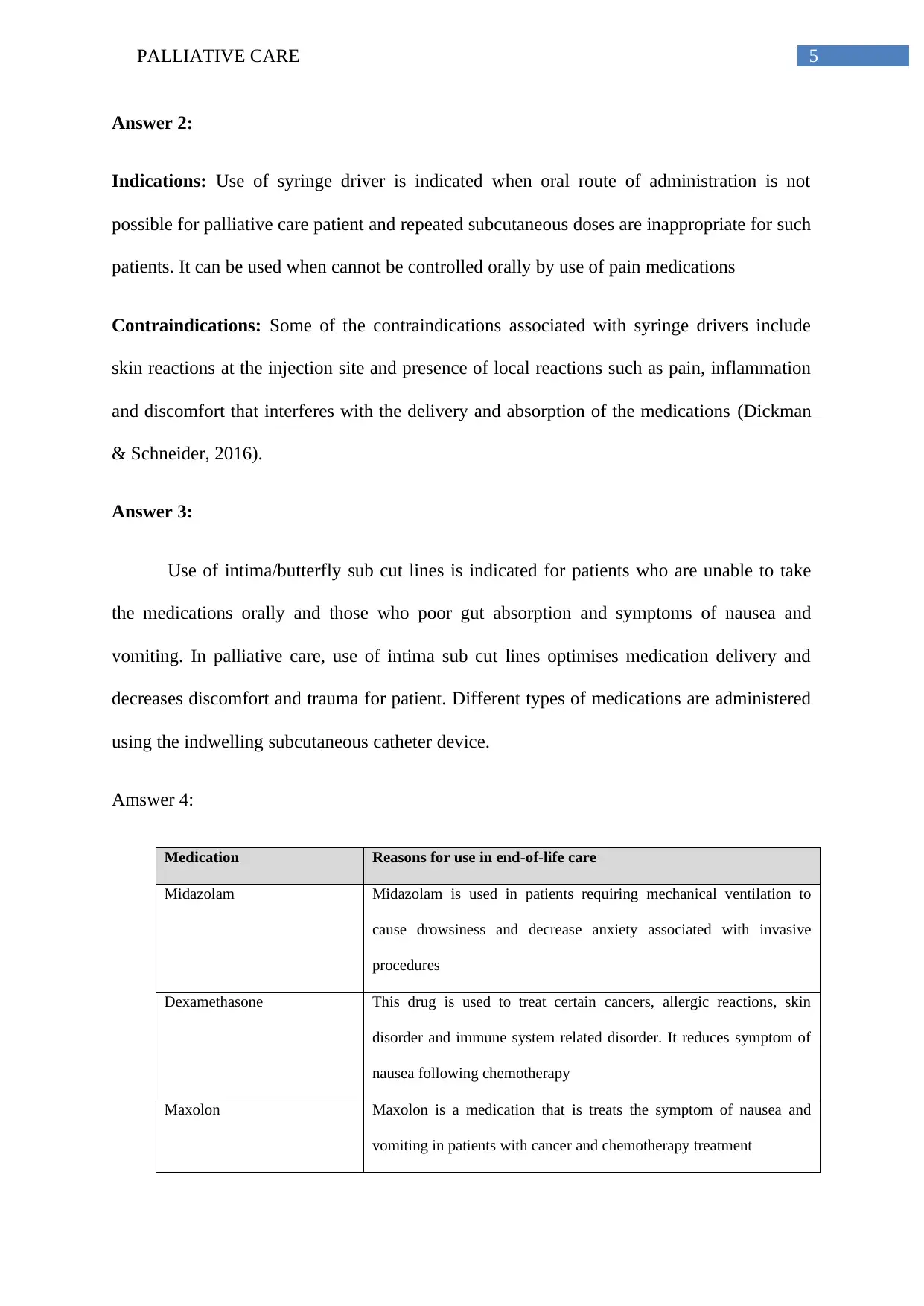
5PALLIATIVE CARE
Answer 2:
Indications: Use of syringe driver is indicated when oral route of administration is not
possible for palliative care patient and repeated subcutaneous doses are inappropriate for such
patients. It can be used when cannot be controlled orally by use of pain medications
Contraindications: Some of the contraindications associated with syringe drivers include
skin reactions at the injection site and presence of local reactions such as pain, inflammation
and discomfort that interferes with the delivery and absorption of the medications (Dickman
& Schneider, 2016).
Answer 3:
Use of intima/butterfly sub cut lines is indicated for patients who are unable to take
the medications orally and those who poor gut absorption and symptoms of nausea and
vomiting. In palliative care, use of intima sub cut lines optimises medication delivery and
decreases discomfort and trauma for patient. Different types of medications are administered
using the indwelling subcutaneous catheter device.
Amswer 4:
Medication Reasons for use in end-of-life care
Midazolam Midazolam is used in patients requiring mechanical ventilation to
cause drowsiness and decrease anxiety associated with invasive
procedures
Dexamethasone This drug is used to treat certain cancers, allergic reactions, skin
disorder and immune system related disorder. It reduces symptom of
nausea following chemotherapy
Maxolon Maxolon is a medication that is treats the symptom of nausea and
vomiting in patients with cancer and chemotherapy treatment
Answer 2:
Indications: Use of syringe driver is indicated when oral route of administration is not
possible for palliative care patient and repeated subcutaneous doses are inappropriate for such
patients. It can be used when cannot be controlled orally by use of pain medications
Contraindications: Some of the contraindications associated with syringe drivers include
skin reactions at the injection site and presence of local reactions such as pain, inflammation
and discomfort that interferes with the delivery and absorption of the medications (Dickman
& Schneider, 2016).
Answer 3:
Use of intima/butterfly sub cut lines is indicated for patients who are unable to take
the medications orally and those who poor gut absorption and symptoms of nausea and
vomiting. In palliative care, use of intima sub cut lines optimises medication delivery and
decreases discomfort and trauma for patient. Different types of medications are administered
using the indwelling subcutaneous catheter device.
Amswer 4:
Medication Reasons for use in end-of-life care
Midazolam Midazolam is used in patients requiring mechanical ventilation to
cause drowsiness and decrease anxiety associated with invasive
procedures
Dexamethasone This drug is used to treat certain cancers, allergic reactions, skin
disorder and immune system related disorder. It reduces symptom of
nausea following chemotherapy
Maxolon Maxolon is a medication that is treats the symptom of nausea and
vomiting in patients with cancer and chemotherapy treatment
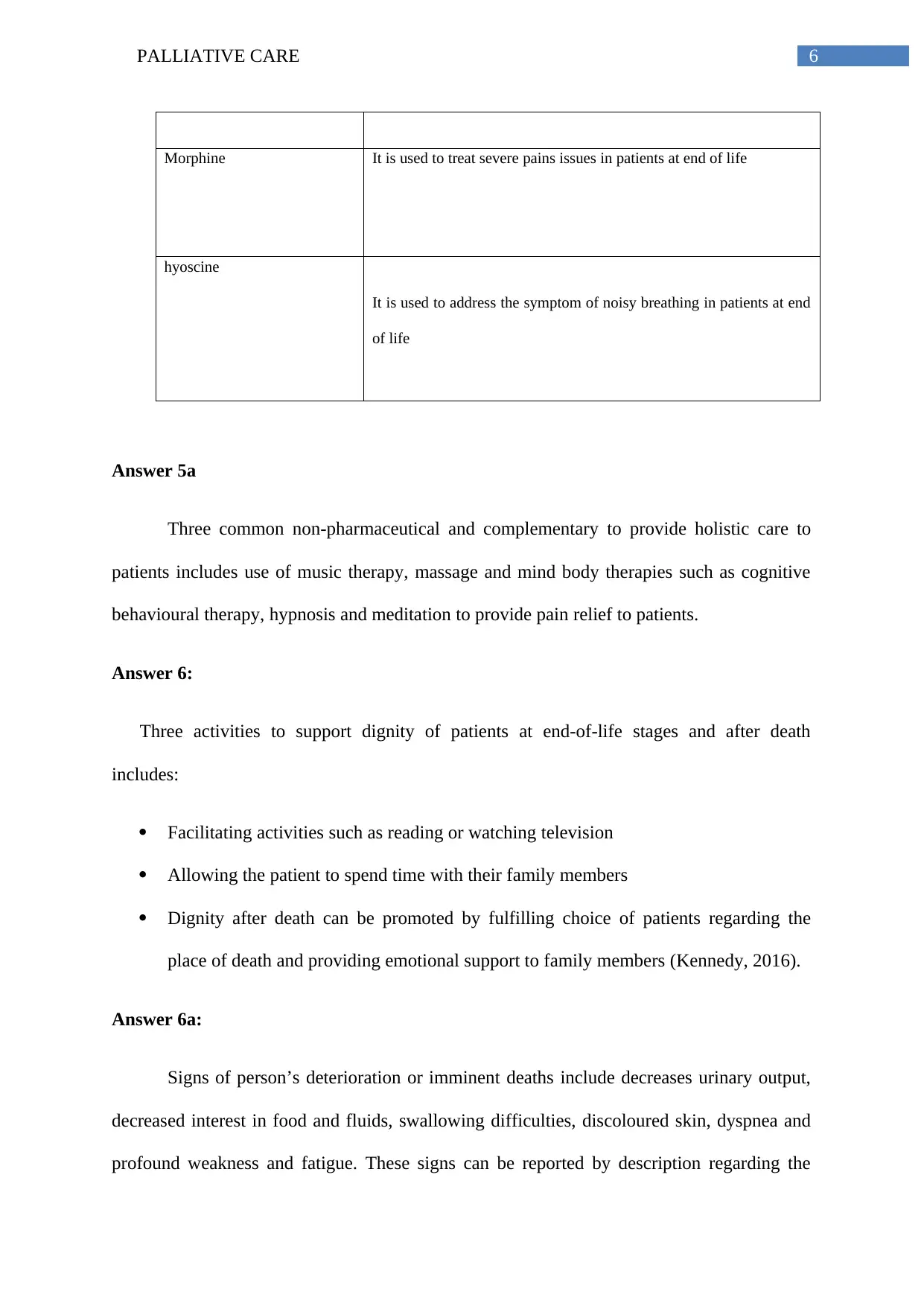
6PALLIATIVE CARE
Morphine It is used to treat severe pains issues in patients at end of life
hyoscine
It is used to address the symptom of noisy breathing in patients at end
of life
Answer 5a
Three common non-pharmaceutical and complementary to provide holistic care to
patients includes use of music therapy, massage and mind body therapies such as cognitive
behavioural therapy, hypnosis and meditation to provide pain relief to patients.
Answer 6:
Three activities to support dignity of patients at end-of-life stages and after death
includes:
Facilitating activities such as reading or watching television
Allowing the patient to spend time with their family members
Dignity after death can be promoted by fulfilling choice of patients regarding the
place of death and providing emotional support to family members (Kennedy, 2016).
Answer 6a:
Signs of person’s deterioration or imminent deaths include decreases urinary output,
decreased interest in food and fluids, swallowing difficulties, discoloured skin, dyspnea and
profound weakness and fatigue. These signs can be reported by description regarding the
Morphine It is used to treat severe pains issues in patients at end of life
hyoscine
It is used to address the symptom of noisy breathing in patients at end
of life
Answer 5a
Three common non-pharmaceutical and complementary to provide holistic care to
patients includes use of music therapy, massage and mind body therapies such as cognitive
behavioural therapy, hypnosis and meditation to provide pain relief to patients.
Answer 6:
Three activities to support dignity of patients at end-of-life stages and after death
includes:
Facilitating activities such as reading or watching television
Allowing the patient to spend time with their family members
Dignity after death can be promoted by fulfilling choice of patients regarding the
place of death and providing emotional support to family members (Kennedy, 2016).
Answer 6a:
Signs of person’s deterioration or imminent deaths include decreases urinary output,
decreased interest in food and fluids, swallowing difficulties, discoloured skin, dyspnea and
profound weakness and fatigue. These signs can be reported by description regarding the
Paraphrase This Document
Need a fresh take? Get an instant paraphrase of this document with our AI Paraphraser
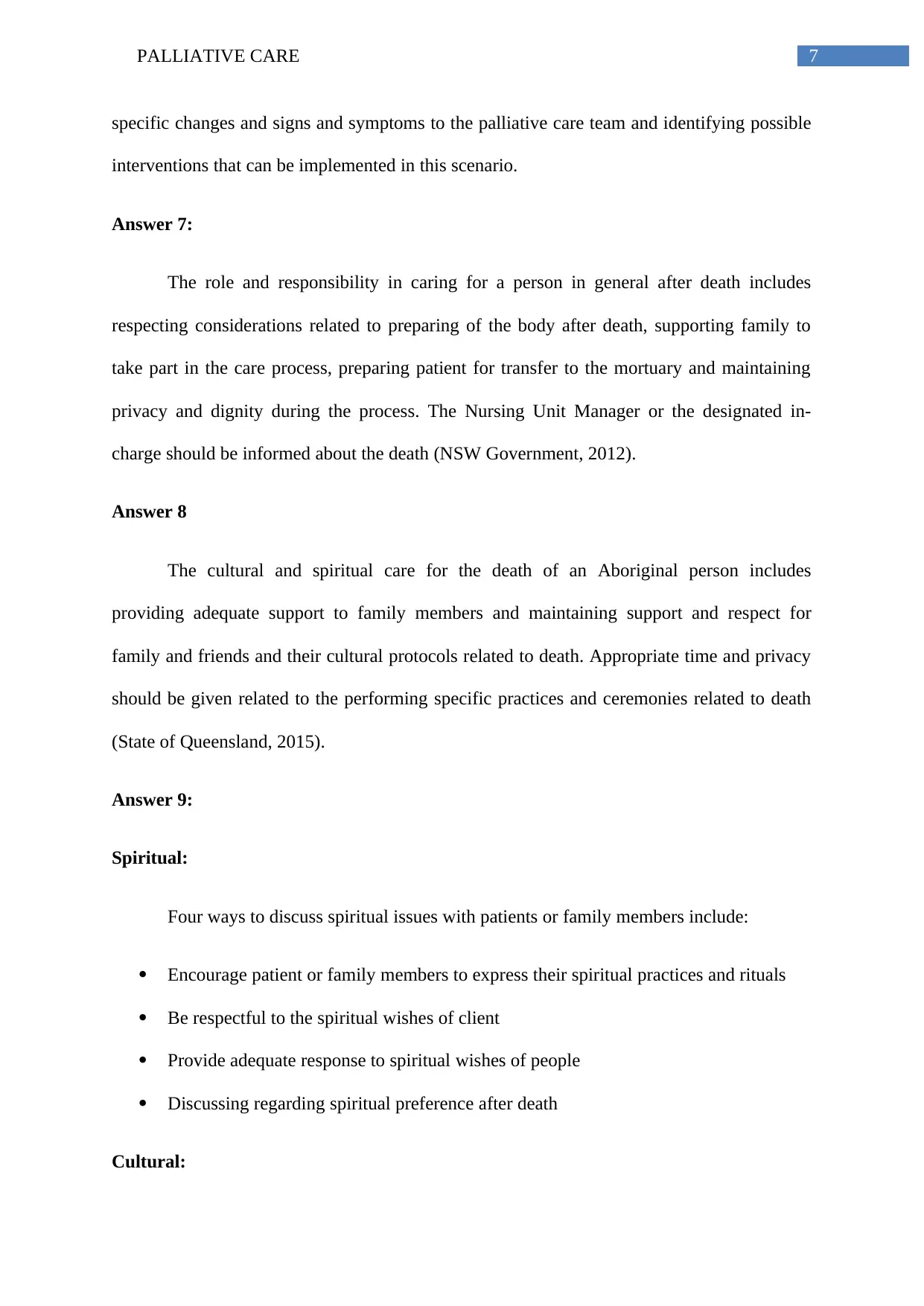
7PALLIATIVE CARE
specific changes and signs and symptoms to the palliative care team and identifying possible
interventions that can be implemented in this scenario.
Answer 7:
The role and responsibility in caring for a person in general after death includes
respecting considerations related to preparing of the body after death, supporting family to
take part in the care process, preparing patient for transfer to the mortuary and maintaining
privacy and dignity during the process. The Nursing Unit Manager or the designated in-
charge should be informed about the death (NSW Government, 2012).
Answer 8
The cultural and spiritual care for the death of an Aboriginal person includes
providing adequate support to family members and maintaining support and respect for
family and friends and their cultural protocols related to death. Appropriate time and privacy
should be given related to the performing specific practices and ceremonies related to death
(State of Queensland, 2015).
Answer 9:
Spiritual:
Four ways to discuss spiritual issues with patients or family members include:
Encourage patient or family members to express their spiritual practices and rituals
Be respectful to the spiritual wishes of client
Provide adequate response to spiritual wishes of people
Discussing regarding spiritual preference after death
Cultural:
specific changes and signs and symptoms to the palliative care team and identifying possible
interventions that can be implemented in this scenario.
Answer 7:
The role and responsibility in caring for a person in general after death includes
respecting considerations related to preparing of the body after death, supporting family to
take part in the care process, preparing patient for transfer to the mortuary and maintaining
privacy and dignity during the process. The Nursing Unit Manager or the designated in-
charge should be informed about the death (NSW Government, 2012).
Answer 8
The cultural and spiritual care for the death of an Aboriginal person includes
providing adequate support to family members and maintaining support and respect for
family and friends and their cultural protocols related to death. Appropriate time and privacy
should be given related to the performing specific practices and ceremonies related to death
(State of Queensland, 2015).
Answer 9:
Spiritual:
Four ways to discuss spiritual issues with patients or family members include:
Encourage patient or family members to express their spiritual practices and rituals
Be respectful to the spiritual wishes of client
Provide adequate response to spiritual wishes of people
Discussing regarding spiritual preference after death
Cultural:
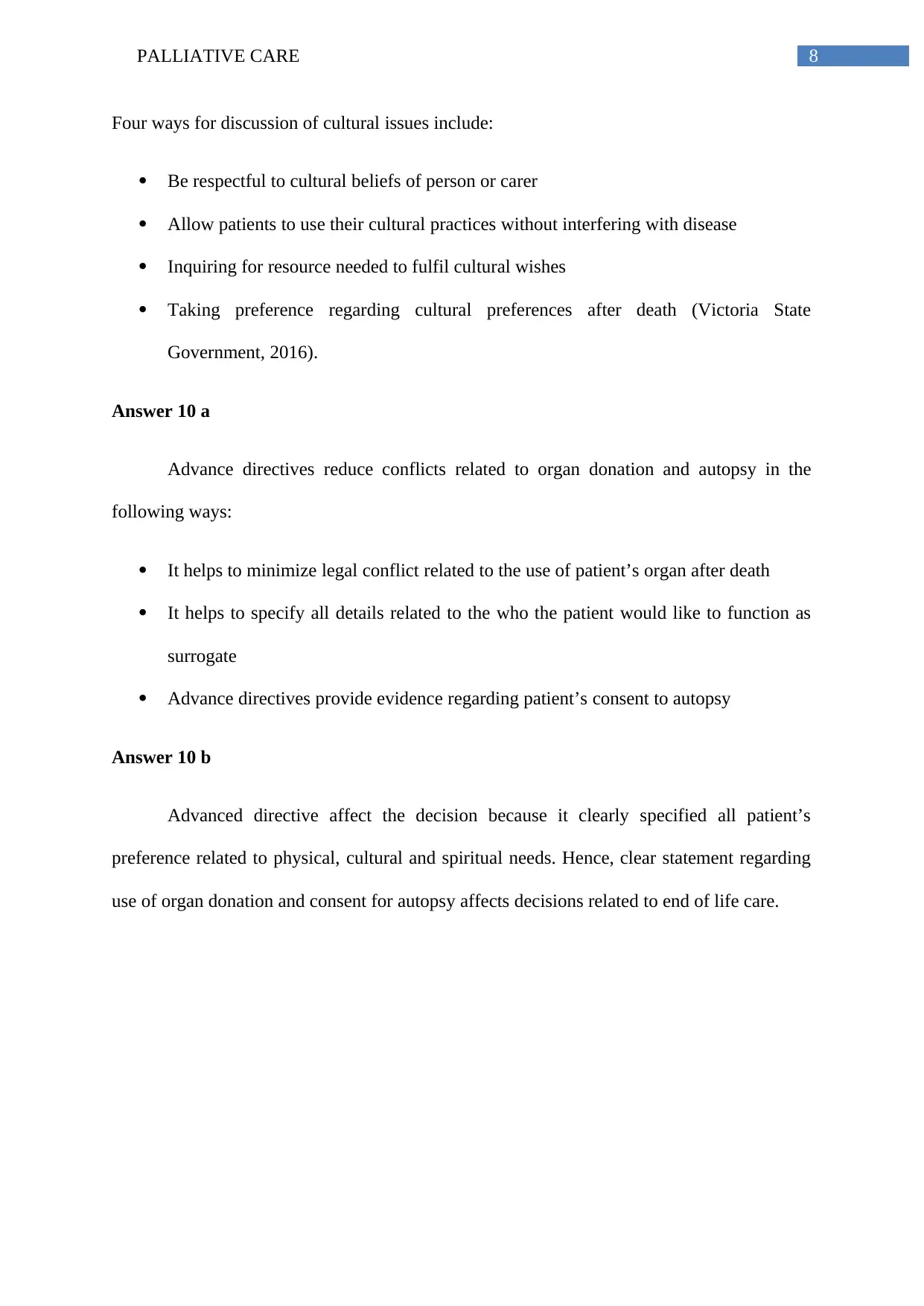
8PALLIATIVE CARE
Four ways for discussion of cultural issues include:
Be respectful to cultural beliefs of person or carer
Allow patients to use their cultural practices without interfering with disease
Inquiring for resource needed to fulfil cultural wishes
Taking preference regarding cultural preferences after death (Victoria State
Government, 2016).
Answer 10 a
Advance directives reduce conflicts related to organ donation and autopsy in the
following ways:
It helps to minimize legal conflict related to the use of patient’s organ after death
It helps to specify all details related to the who the patient would like to function as
surrogate
Advance directives provide evidence regarding patient’s consent to autopsy
Answer 10 b
Advanced directive affect the decision because it clearly specified all patient’s
preference related to physical, cultural and spiritual needs. Hence, clear statement regarding
use of organ donation and consent for autopsy affects decisions related to end of life care.
Four ways for discussion of cultural issues include:
Be respectful to cultural beliefs of person or carer
Allow patients to use their cultural practices without interfering with disease
Inquiring for resource needed to fulfil cultural wishes
Taking preference regarding cultural preferences after death (Victoria State
Government, 2016).
Answer 10 a
Advance directives reduce conflicts related to organ donation and autopsy in the
following ways:
It helps to minimize legal conflict related to the use of patient’s organ after death
It helps to specify all details related to the who the patient would like to function as
surrogate
Advance directives provide evidence regarding patient’s consent to autopsy
Answer 10 b
Advanced directive affect the decision because it clearly specified all patient’s
preference related to physical, cultural and spiritual needs. Hence, clear statement regarding
use of organ donation and consent for autopsy affects decisions related to end of life care.
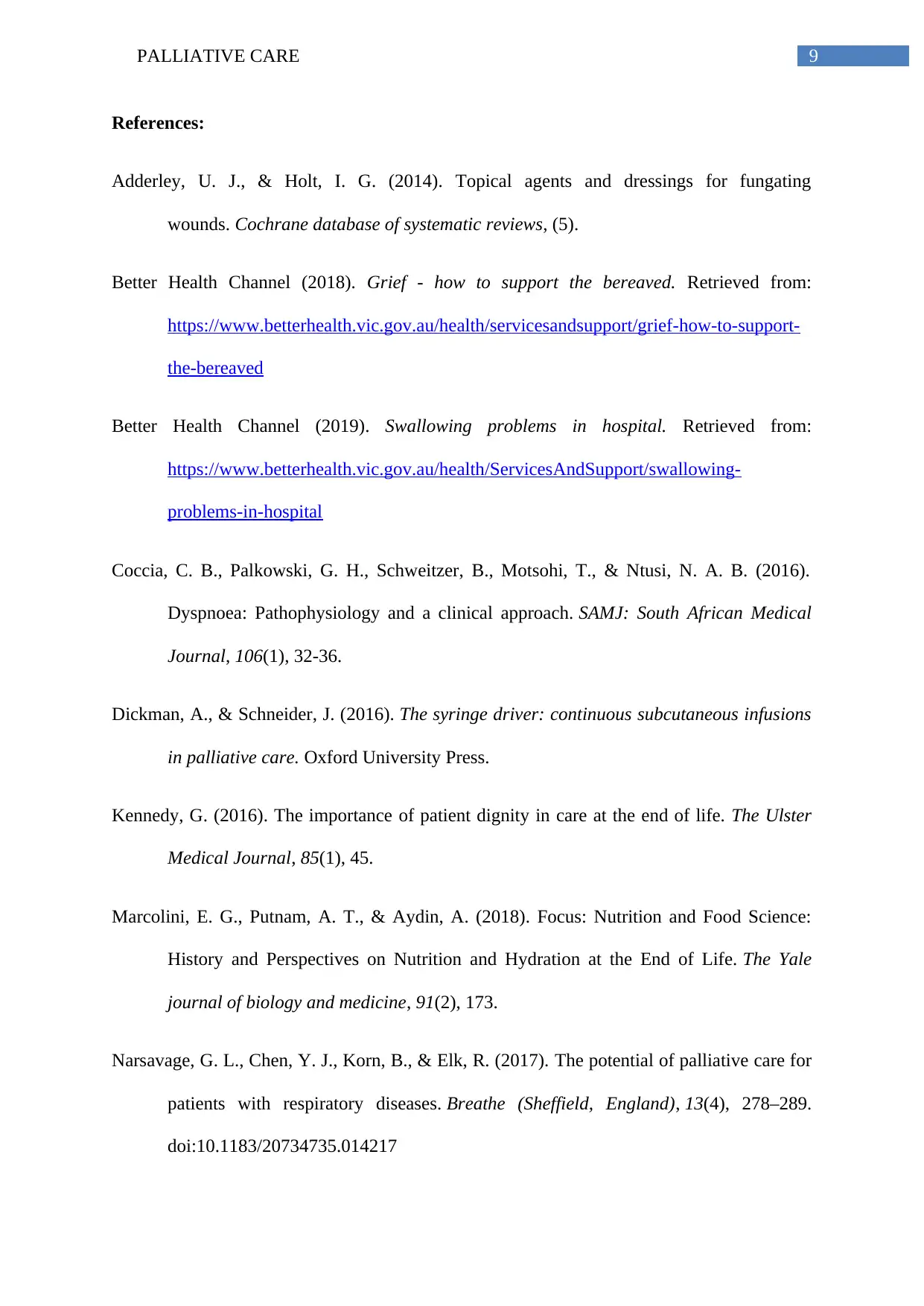
9PALLIATIVE CARE
References:
Adderley, U. J., & Holt, I. G. (2014). Topical agents and dressings for fungating
wounds. Cochrane database of systematic reviews, (5).
Better Health Channel (2018). Grief - how to support the bereaved. Retrieved from:
https://www.betterhealth.vic.gov.au/health/servicesandsupport/grief-how-to-support-
the-bereaved
Better Health Channel (2019). Swallowing problems in hospital. Retrieved from:
https://www.betterhealth.vic.gov.au/health/ServicesAndSupport/swallowing-
problems-in-hospital
Coccia, C. B., Palkowski, G. H., Schweitzer, B., Motsohi, T., & Ntusi, N. A. B. (2016).
Dyspnoea: Pathophysiology and a clinical approach. SAMJ: South African Medical
Journal, 106(1), 32-36.
Dickman, A., & Schneider, J. (2016). The syringe driver: continuous subcutaneous infusions
in palliative care. Oxford University Press.
Kennedy, G. (2016). The importance of patient dignity in care at the end of life. The Ulster
Medical Journal, 85(1), 45.
Marcolini, E. G., Putnam, A. T., & Aydin, A. (2018). Focus: Nutrition and Food Science:
History and Perspectives on Nutrition and Hydration at the End of Life. The Yale
journal of biology and medicine, 91(2), 173.
Narsavage, G. L., Chen, Y. J., Korn, B., & Elk, R. (2017). The potential of palliative care for
patients with respiratory diseases. Breathe (Sheffield, England), 13(4), 278–289.
doi:10.1183/20734735.014217
References:
Adderley, U. J., & Holt, I. G. (2014). Topical agents and dressings for fungating
wounds. Cochrane database of systematic reviews, (5).
Better Health Channel (2018). Grief - how to support the bereaved. Retrieved from:
https://www.betterhealth.vic.gov.au/health/servicesandsupport/grief-how-to-support-
the-bereaved
Better Health Channel (2019). Swallowing problems in hospital. Retrieved from:
https://www.betterhealth.vic.gov.au/health/ServicesAndSupport/swallowing-
problems-in-hospital
Coccia, C. B., Palkowski, G. H., Schweitzer, B., Motsohi, T., & Ntusi, N. A. B. (2016).
Dyspnoea: Pathophysiology and a clinical approach. SAMJ: South African Medical
Journal, 106(1), 32-36.
Dickman, A., & Schneider, J. (2016). The syringe driver: continuous subcutaneous infusions
in palliative care. Oxford University Press.
Kennedy, G. (2016). The importance of patient dignity in care at the end of life. The Ulster
Medical Journal, 85(1), 45.
Marcolini, E. G., Putnam, A. T., & Aydin, A. (2018). Focus: Nutrition and Food Science:
History and Perspectives on Nutrition and Hydration at the End of Life. The Yale
journal of biology and medicine, 91(2), 173.
Narsavage, G. L., Chen, Y. J., Korn, B., & Elk, R. (2017). The potential of palliative care for
patients with respiratory diseases. Breathe (Sheffield, England), 13(4), 278–289.
doi:10.1183/20734735.014217
Secure Best Marks with AI Grader
Need help grading? Try our AI Grader for instant feedback on your assignments.
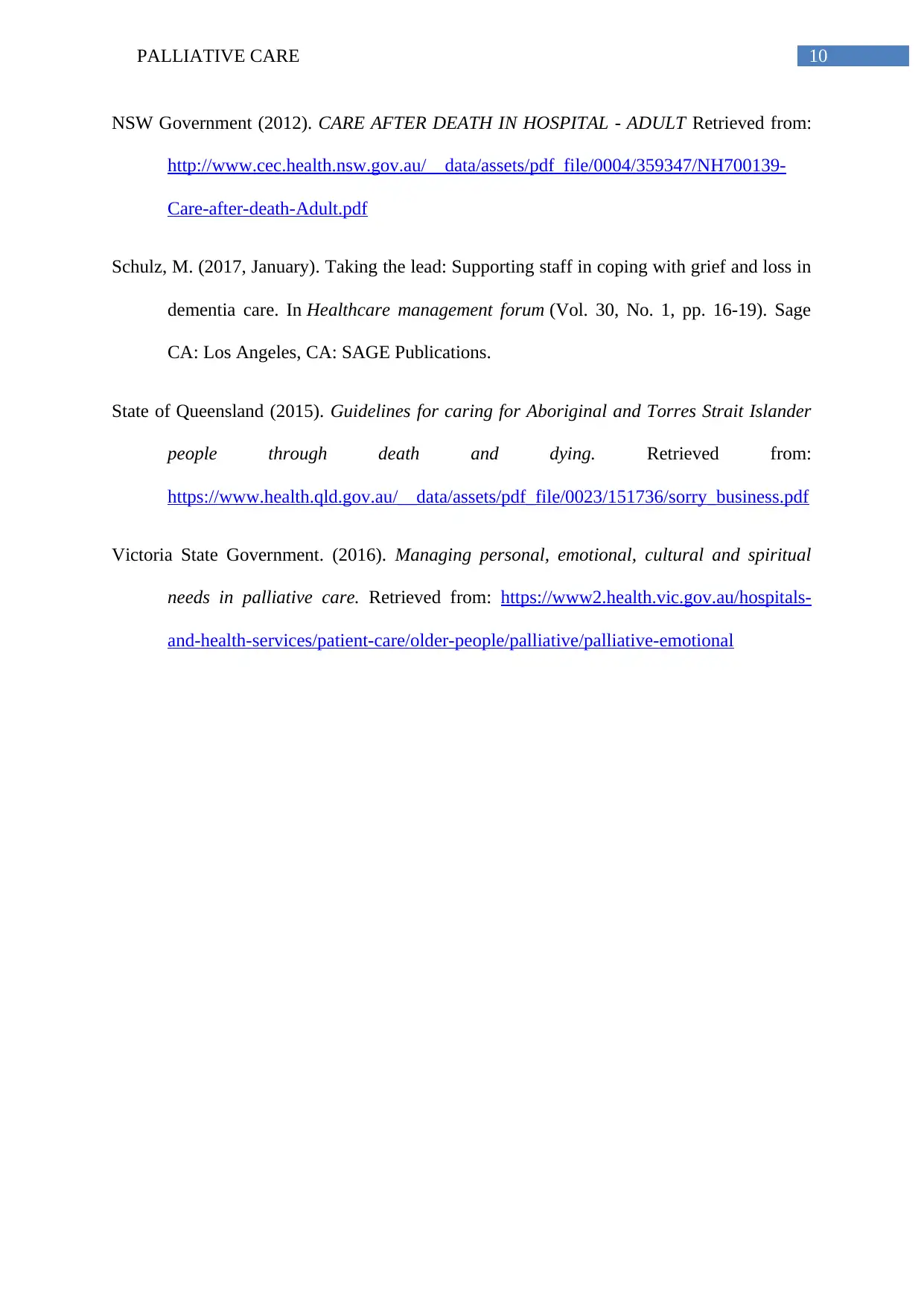
10PALLIATIVE CARE
NSW Government (2012). CARE AFTER DEATH IN HOSPITAL - ADULT Retrieved from:
http://www.cec.health.nsw.gov.au/__data/assets/pdf_file/0004/359347/NH700139-
Care-after-death-Adult.pdf
Schulz, M. (2017, January). Taking the lead: Supporting staff in coping with grief and loss in
dementia care. In Healthcare management forum (Vol. 30, No. 1, pp. 16-19). Sage
CA: Los Angeles, CA: SAGE Publications.
State of Queensland (2015). Guidelines for caring for Aboriginal and Torres Strait Islander
people through death and dying. Retrieved from:
https://www.health.qld.gov.au/__data/assets/pdf_file/0023/151736/sorry_business.pdf
Victoria State Government. (2016). Managing personal, emotional, cultural and spiritual
needs in palliative care. Retrieved from: https://www2.health.vic.gov.au/hospitals-
and-health-services/patient-care/older-people/palliative/palliative-emotional
NSW Government (2012). CARE AFTER DEATH IN HOSPITAL - ADULT Retrieved from:
http://www.cec.health.nsw.gov.au/__data/assets/pdf_file/0004/359347/NH700139-
Care-after-death-Adult.pdf
Schulz, M. (2017, January). Taking the lead: Supporting staff in coping with grief and loss in
dementia care. In Healthcare management forum (Vol. 30, No. 1, pp. 16-19). Sage
CA: Los Angeles, CA: SAGE Publications.
State of Queensland (2015). Guidelines for caring for Aboriginal and Torres Strait Islander
people through death and dying. Retrieved from:
https://www.health.qld.gov.au/__data/assets/pdf_file/0023/151736/sorry_business.pdf
Victoria State Government. (2016). Managing personal, emotional, cultural and spiritual
needs in palliative care. Retrieved from: https://www2.health.vic.gov.au/hospitals-
and-health-services/patient-care/older-people/palliative/palliative-emotional
1 out of 11
Your All-in-One AI-Powered Toolkit for Academic Success.
+13062052269
info@desklib.com
Available 24*7 on WhatsApp / Email
![[object Object]](/_next/static/media/star-bottom.7253800d.svg)
Unlock your academic potential
© 2024 | Zucol Services PVT LTD | All rights reserved.



